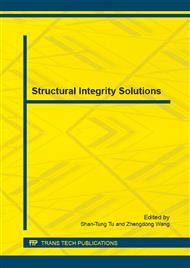p.251
p.261
p.266
p.272
p.279
p.285
p.295
p.307
p.316
Structural Integrity Assessments by Measuring of Residual Stresses and Brittle Crack Toughness: A Thick Large-Scale Welding Study
Abstract:
Residual stresses inherently occur in welds and through-thickness distributions in an extra thick weld is unclear to date, though it is important in various steel, plant, and shipbuilding industries. Here introduce a recent complementary technique to determine residual stress measurement methods. Spatial variations of residual stresses were determined through the thickness of 70-mm thick ferritic steel welds created using low heat-input (1.7 kJ/mm) one-pass electro-gas welding (EGW) and high heat-input (56 kJ/mm) multi-pass flux-cored arc welding (FCAW). The results show that significant tensile stresses (about 90% of yield strength) occur along the weld centerline near the top surface (within 10% of the depth) in the FCAW specimen. Meanwhile, in the EGW weld, the peak stress moved towards the heat-affected zone at a depth of about 40% of the thickness due to the high heat-input. Secondly, large-scale (1 x 1 m) brittle fracture experiments have been performed to examine the brittle crack-arrest toughness and crack propagation path in each case. The fracture behavior compares to the observations of the grain size, hardness, and Charpy impact energy of the localized crack region in each weld. This study provides an insight in terms of the relevance between residual stresses and the brittle fracture behavior.
Info:
Periodical:
Pages:
279-284
Citation:
Online since:
April 2015
Authors:
Price:
Сopyright:
© 2015 Trans Tech Publications Ltd. All Rights Reserved
Share:
Citation:


